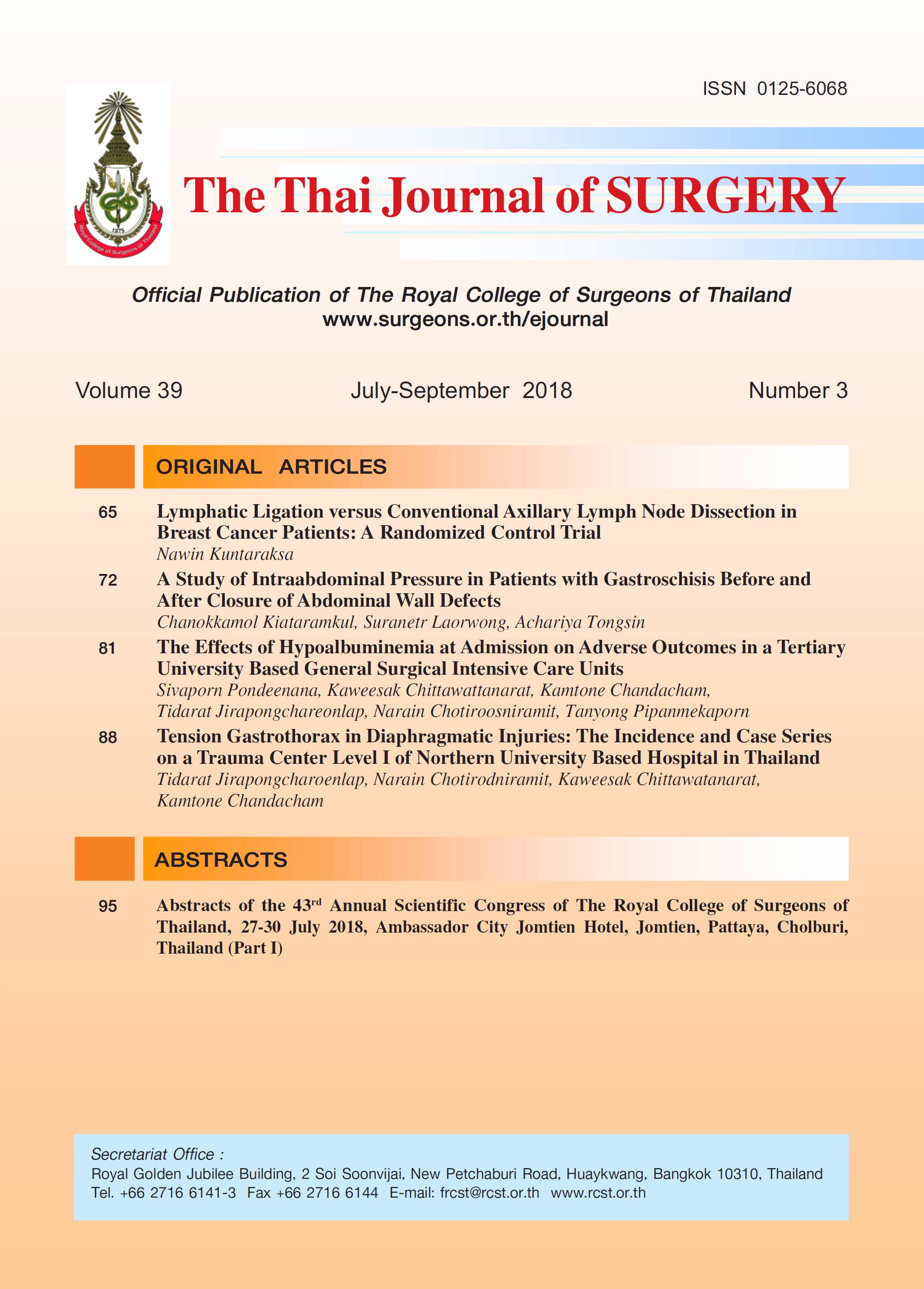A Study of Intraabdominal Pressure in Patients with Gastroschisis Before and After Closure of Abdominal Wall Defects
Keywords:
Gastroschisis, intraabdominal pressure, intraabdominal hypertension, abdominal compartment syndrome, primary closure procedure, staged closure procedureAbstract
Background: Ordinary treatments in patients with gastroschisis are primary and staged closure of abdominal wall defects (AWDs). The goal of treatment is to return the visceral organs into the abdominal cavity and minimize risks of increased intraabdominal pressure (IAP). Abdominal compartment syndrome (ACS) is the serious complication which induces to develop renal failure, bowel ischemia, respiratory compromise and death. IAP over 10 mmHg is defined as intraabdominal hypertension (IAH) and may induce to develop ACS.
Purpose: The aim of this study is to analyse IAP before and after closure of AWDs in patients with gastroschisis and investigate the factor affected increment of IAP. Materials and Methods: The patients with gastroschisis who were treated at Queen Sirikit National Institute of Child Health from January 2017 to December 2017 were enrolled into the study. IAP was measured by using of urinary bladder pressure between before and after closure of AWDs in both primary and staged closure procedures. Demographic data, IAP and complications were collected in order to demonstrate the relationship by using statistical analysis with SPSS program. The level of p-value less than 0.5 was considered statistical significance.
Results: Twenty-six patients (15 males, 11 females) were enrolled in the study. The patients were treated by primary closure procedure in 3 cases and staged closure procedure in 23 cases. In the primary closure group, median IAP before treatment was 8.09 mmHg (range 4.41-8.09 mmHg), whereas median IAP after closure of AWDs was 10.3 mmHg (range 4.41-20.96 mmHg). In the staged closure group, median IAP before treatment was 5.88 mmHg (range 2.21-22.07 mmHg), whereas median IAP after closure of AWDs was 8.46 mmHg (range 2.94-22.07 mmHg). Of the total 26 patients, 8 cases (30.76%) had IAH after closure of AWDs with the IAPs ranging from 10.3 to 22.07 mmHg. Two of the 8 cases with IAH (7.69% of all the patients) cases developed ACS with acute respiratory insufficiency, one case in the primary closure group (IAP 20.96 mmHg) and the other one in the staged closure group (IAP 22.07 mmHg). Both cases were treated by endotracheal intubation and respiratory support until they recovered within 3 days. There was not statistically significant in comparing of IAP between primary and staged closure procedures in the periods of before and after closure of AWDs (p > 0.05). Demographic data, type of operative procedures and complications were not associated to high IAP (> 10 mmHg) in this study.
Conclusion: Comparison between primary and staged closure procedures, there was no statistically significant of IAP in patients with gastroschisis before and after closure of AWDs. However, approximately 8 % of the patients developed ACS immediately postoperative closure of AWDs. Demographic data, type of operative procedures and comorbidities were not statistically associated with IAH after closure of AWDs.
References
2. Srivastava V, Mandhan P, Prinkle K, et al. Rising incidence of gastroschisis and exomphalos in New Zealand. J Pediatr Surg 2009;44:551-5.
3. Shansk e AL, Pande S, Aref K, et al. Omphalocele - exstrophy imperforate anus - spinal defects (OEIS) in tripet pregnancy after IVF and CVS. Birth Defects Res A Clin Mol Teratol 2003;67:467.
4. Islam S. Congenital abdominal wall defects. In : Holcomb GW III, Murphy JP, Ostile DJ, eds. Ashcraft’s pediatric surgery. 6th ed. London, New York : Elsevier - Saunders; 2014. p. 660-72.
5. Kirkpatrick AW, Roberts DJ, De Wacle J, et al. Intra-abdominal hypertension and the abdominal compartment syndrome : updated consensus definitions and clinical practice guidelines from the World Society of the Abdominal Compartment Syndrome. Intensive Care Med 2013;39: 1190-206.
6. Niramis R, Watanatittan S, Anuntkosol M, et al. Gastroschisis : results of the treatment in 342 neonatal. J Int Coll Surg Thai
1998;41:7-11.
7. Suttiwongsing A, Sriworarak R, Buranakitjaroen V, et al. Related factors in necrotizing enterocolitis after gastroschisis repair. Thai J Surg 2011;32:113-8.
8. Niramis R, Suttiwongsing A, Buranakitjaroen V, et al. Clinical outcome of patients with gastroschisis : What are the differences from the past? J Med Assoc Thai 2011; 94 (Suppl3):S49-56.
9. Convert centimeters of water to millimeters of mercury (cmH2O to mmHg. http//www.conversion.com).
10. Lacey SR, Carris LA, Beyer AJ 3rd, et al. Bladder pressure monitoring significantly enhances care of infants with abdominal wall defects: A prospective clinical study. J
Pediatr Surg 1993;28:1370-4.
11. Ein SH, Superina R, Bagwell C, et al. Ischemic bowel after primary closure for gastroschisis. J Pediatr Surg 1988;23:728-30.
12. Divarci E, Karapinar B, Yalaz M, et al. Incidence and prognosis of intraabdominal hypertension and abdominal compartment syndrome in children. J Pediatr Surg 2016;51:503-7.
13. Davis PJ, Koottayi S, Taylor A, et al. Comparison of indirect methods of measuring intraabdominal pressure in children. Intensive Care Med 2005;31:471-5.
14. Suominen PK, Pakarinen MP, Rautiainen P, et al. Comparison of direct and intravesicalmeasurement of intraabdominal pressure in children. J Pediatr Surg 2006;41:1381-5.
15. Olesevich M, Alexander F, Khan M, et al. Gastroschisis revisited: role of intraoperative measurement of abdominal pressure. J Pediatr Surg 2005;40:789-92.
16. Schmidt AFS, Goncalves A, Murray J, et al. Monitoring intravesical pressure during gastroschisis closure. Does it help to decide between delayed primary or stage closure?. J Matern Fetal Neonatal Med 2012;25:1438-41.
Downloads
Published
How to Cite
Issue
Section
License
Articles must be contributed solely to The Thai Journal of Surgery and when published become the property of the Royal College of Surgeons of Thailand. The Royal College of Surgeons of Thailand reserves copyright on all published materials and such materials may not be reproduced in any form without the written permission.



